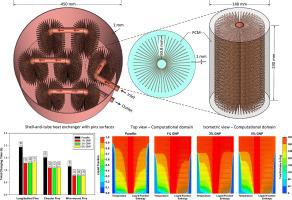当前位置:
X-MOL 学术
›
Energy Convers. Manag.
›
论文详情
Our official English website, www.x-mol.net, welcomes your
feedback! (Note: you will need to create a separate account there.)
Role of extended fins and graphene nano-platelets in coupled thermal enhancement of latent heat storage system
Energy Conversion and Management ( IF 9.9 ) Pub Date : 2020-11-01 , DOI: 10.1016/j.enconman.2020.113349 Zakir Khan , Zulfiqar Ahmad Khan
Energy Conversion and Management ( IF 9.9 ) Pub Date : 2020-11-01 , DOI: 10.1016/j.enconman.2020.113349 Zakir Khan , Zulfiqar Ahmad Khan

|
Abstract To bring modernisation in low carbon economy, the latent heat storage (LHS) systems are crucial for sustainable future of smart energy generation and management systems for renewable sources. This article provides in–depth numerical analyses of 3-dimensional computational models incorporating coupled thermal enhancement techniques for identifying optimal solution to guarantee higher charging rate, higher total enthalpy and better thermal distribution of LHS system. Paraffin is selected as phase change material (PCM), graphene nano-platelets (GNP) as nano-additives and longitudinal, circular and wire-wound fins as extended surfaces in vertical shell-and-tube configurations. Based on numerical analyses, the extended surfaces have registered better thermal distributions and charging rates as compared to nano-PCMs. The geometrical orientation of extended surfaces and volume concentration of nano-additives have significant influence on melt front movement, natural convection and heat transfer performance. The peak values of heat fluxes are significantly increased from 2.25 kW/m2 for paraffin without thermal enhancement to 35.86, 47.23 and 88.13 kW/m2 for nano-PCM with 1% GNP in circular, longitudinal and wire-wound fins configurations. Hence, the charging duration for capturing 11.09 MJ is significantly reduced to mere 1.02 h for wire-wound fins configuration as compared to 23.5 h for paraffin without thermal enhancement. Likewise, the charging rate of wire-wound fins configuration is 20.95%, 35.96% and 89.94% higher than circular fins, longitudinal fins and nano-PCMs without extended surfaces, respectively. The increase in volume concentration from 1% to 5% has exhibited adverse implications on accumulative enthalpy, natural convection and charging rate. Therefore, the novel design of coupled enhancement with wire-wound fins configuration and nano-PCM with 1% GNP are established as optimum solution for potential wide-ranging practical utilisations of LHS system.
中文翻译:

扩展鳍片和石墨烯纳米片在潜热储存系统耦合热增强中的作用
摘要 为了实现低碳经济的现代化,潜热储存(LHS)系统对于智能能源生产和可再生能源管理系统的可持续未来至关重要。本文对结合了耦合热增强技术的 3 维计算模型进行了深入的数值分析,以确定最佳解决方案,以保证 LHS 系统具有更高的充电率、更高的总焓和更好的热分布。石蜡被选为相变材料 (PCM),石墨烯纳米片 (GNP) 作为纳米添加剂,纵向、圆形和线绕翅片作为垂直壳管结构中的延伸表面。根据数值分析,与纳米 PCM 相比,扩展表面具有更好的热分布和充电速率。扩展表面的几何取向和纳米添加剂的体积浓度对熔体前沿运动、自然对流和传热性能有显着影响。在圆形、纵向和线绕翅片配置中,热通量的峰值从没有热增强的石蜡的 2.25 kW/m2 显着增加到 35.86、47.23 和 88.13 kW/m2 的具有 1% GNP 的纳米 PCM。因此,与没有热增强的石蜡的 23.5 小时相比,线绕翅片配置捕获 11.09 MJ 的充电持续时间显着减少到仅 1.02 小时。同样,线绕翅片配置的充电率分别比圆形翅片、纵向翅片和无扩展表面的纳米 PCM 高 20.95%、35.96% 和 89.94%。体积浓度从 1% 增加到 5% 对累积焓、自然对流和充电率产生不利影响。因此,线绕翅片结构耦合增强的新颖设计和具有 1% GNP 的纳米 PCM 被确立为 LHS 系统潜在广泛实际应用的最佳解决方案。
更新日期:2020-11-01
中文翻译:

扩展鳍片和石墨烯纳米片在潜热储存系统耦合热增强中的作用
摘要 为了实现低碳经济的现代化,潜热储存(LHS)系统对于智能能源生产和可再生能源管理系统的可持续未来至关重要。本文对结合了耦合热增强技术的 3 维计算模型进行了深入的数值分析,以确定最佳解决方案,以保证 LHS 系统具有更高的充电率、更高的总焓和更好的热分布。石蜡被选为相变材料 (PCM),石墨烯纳米片 (GNP) 作为纳米添加剂,纵向、圆形和线绕翅片作为垂直壳管结构中的延伸表面。根据数值分析,与纳米 PCM 相比,扩展表面具有更好的热分布和充电速率。扩展表面的几何取向和纳米添加剂的体积浓度对熔体前沿运动、自然对流和传热性能有显着影响。在圆形、纵向和线绕翅片配置中,热通量的峰值从没有热增强的石蜡的 2.25 kW/m2 显着增加到 35.86、47.23 和 88.13 kW/m2 的具有 1% GNP 的纳米 PCM。因此,与没有热增强的石蜡的 23.5 小时相比,线绕翅片配置捕获 11.09 MJ 的充电持续时间显着减少到仅 1.02 小时。同样,线绕翅片配置的充电率分别比圆形翅片、纵向翅片和无扩展表面的纳米 PCM 高 20.95%、35.96% 和 89.94%。体积浓度从 1% 增加到 5% 对累积焓、自然对流和充电率产生不利影响。因此,线绕翅片结构耦合增强的新颖设计和具有 1% GNP 的纳米 PCM 被确立为 LHS 系统潜在广泛实际应用的最佳解决方案。











































 京公网安备 11010802027423号
京公网安备 11010802027423号